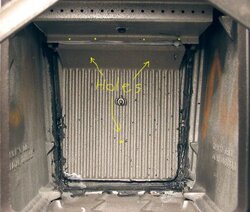Hey ml, good questions.
ml said:
Precaud: Your thoughts on K28, thermal ceramics,45%alumina,52%silicia, 1% ferric oxide. Better than K23`s???
If you're referring to these:
http://cgi.ebay.com/Firebrick-kiln-ceramic-oven-15-pr-bx-Morgan-K-28-silica_W0QQitemZ290263097610
I have the specs on them. The 51 pcf density is pretty much equal to the pumice bricks. Crush strength is higher than the K23, so my guess is they are pretty much on a par with the pumice bricks in their handling of abrasion and bumps. They have better radiant reflection due to their whiter color. I may order a box of them this week. The price can't be beat.
MY mind keeps telling me whenever I read.,(...the brick used in kiln manufacturing...) that a kiln wants a brick which holds ,,rather than transfers heat,,. Does my mind have a mental block, or are these the type I want??
Yes, they are the type you want. And yes, it's a mental block, caused by the use of the word "hold." Why do you want to hold heat in the lining? What for? You don't want to hold it, you want to stop it from escaping so that the interior space stays hotter. You have to separate in your mind:
1. the physical kiln from the space inside it. And for a woodstove,
2. Keeping the combustion environment hot from getting the heat out (the heat exchanger.)
If you try to do both in the same space you'll do neither very well.
Imagine this: you're in a one-room house with steel walls. You're putting heat into it, and you want to get the temps as high as possible inside the house. To achieve this, what treatment would you apply to the inside of the steel walls: line them with 2.5" of heavy brick, or spray 2.5" of lightweight foam insulation? The brick will store heat and even out the temperature fluctuations in the room. But that isn't the goal. The insulation will be MUCH better at stopping the loss of heat and making the inside temperatures higher.
You don't want
even heat over time inside the firebox; you want it as hot as possible while flames exist in it.
Regarding the installation of a BAFFLE: Between the secondary tubes,baffle,1"insulation blankett, a lot of cu.ft gets consumed> Your thoughts on a free 1/2 in. stainless baffle coated with itc100 ceramic coating, to minimize cu.ft. reduction by not using the 1" insulation blanket. I think cost would equal out and leave more space.
Interesting idea. But how about a 1/2" ceramic fiber board? It weighs alot less than the stainless baffle and is a better insulator.
would cutting brick thickness down to 1" be acceptible??
I'm thinking of the doing same thing, to replace 1" of vermiculite. As long as it's dense enough to hold up, I don't see why not.
IT seems that the "whitest " "or""( absense of color) in a brick are manufactured in either India or China. Not exclusive of course,,its just when I find a new link,,,its far away, and again I cant decifer the test charts. Thanks
Yeah, the dust created is nasty stuff... inside-the-factory health regs are probably looser over there... make sure you wear a mask if you cut bricks down.
 rice ratio.
rice ratio. rice ratio.
rice ratio.

 All three loads left no unburned wood in the back - the raised internal temps appear to be enough to gassify the whole load now. This stove is now performing as I thought it would when I bought it, and is no longer an underperformer.
All three loads left no unburned wood in the back - the raised internal temps appear to be enough to gassify the whole load now. This stove is now performing as I thought it would when I bought it, and is no longer an underperformer.